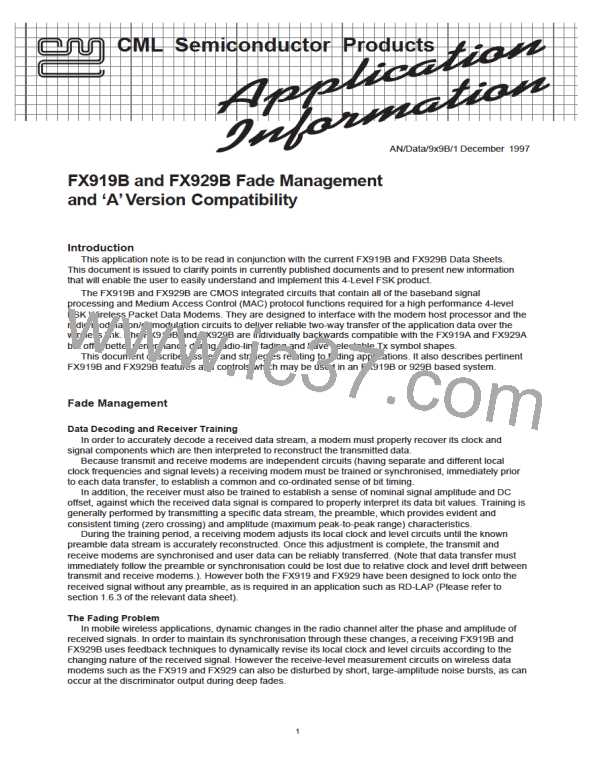Changes to the Level Measurement Modes
These are controlled by the Control Register LEVRES field (bits 2 and 3) as below:
Control Register Bits
B3
0
B2
0
FX919A and FX929A
Hold
FX919B and FX929B
Hold
0
1
Slow Peak Detect
Lossy Peak Detect
Clamp
Level Track
1
0
Lossy Peak Detect
Slow Peak Detect
1
1
The normal recommended setting will still be ‘0 1’, which will select ‘Level Track’ on the FX919and FX929B
devices in place of the previous ‘Slow Peak Detect’ mode, thus giving improved performance without any
software changes.
The old ‘Slow Peak Detect’ mode may be useful in some particular circumstances, particularly for some
FX919B applications, so it has been retained as a user-selectable option, replacing the old ‘CLAMP’ option.
Note that the CLAMP mode will no longer be program selectable, although it will remain as an internal mode
used at the start of a AQLEV acquisition sequence.
Thus the automatic AQLEV acquisition sequence has also changed:
FX919A and FX929A AQLEV Sequence
Clamp for 1 Symbol.
FX919B and FX929B AQLEV Sequence
Clamp for 1 symbol.
Lossy Peak Detect for 15 symbols.
Slow Peak Detect.**
Lossy Peak Detect for 15 symbols.
Slow Peak Detect until Frame Sync. Detected.
Level Track.**
** Assuming that the LEVRES bits of the control register are set to ‘0 1’ (Slow Peak Detect for
FX919A and FX929A devices), which in practice they would be on existing software. Otherwise
the level measurement circuits will revert to whatever other mode has been set in the Control
Register.
Transmit Symbol Shapes
The FX919B and FX929B include the additional feature of selectable Tx symbol shapes (Please refer to
section 1.5.7 of the current data sheets), this feature allows these devices to communicate effectively with
various OEM’s base station equipment (e.g. in RD-LAP applications).
Summary
The FX919B and FX929B will give better immunity to fading than the FX919 and FX929A and are soft-
ware compatible as long as the ‘Clamp’ mode is not currently being used. Please note however for FX919B
applications where isolated messages are being sent with indeterminate length gaps of unmodulated carrier,
it is recommended that the LEVRES mode is set to ‘Slow Peak Detect’ mode when searching for a Frame
Sync., reverting to ‘Track’ mode when Frame Sync. has been detected and while the message is being
received.
Note that this Application Note is intended to be used in conjunction with the current CML Product Data Sheet; printed Specifications apply.
CML does not assume any responsibility for the use of any circuitry described. No circuit patent licences are implied
and CML reserves the right at any time without notice to change the said circuitry.
Telephone: +44 1376 513833
CONSUMER MICROCIRCUITS LIMITED
Telefax: +44 1376 518247
e-mail: sales@cmlmicro.co.uk
http://www.cmlmicro.co.uk
1 WHEATON ROAD - WITHAM - ESSEX CM8 3TD - ENGLAND
© 1997 Consumer Microcircuits Limited

 CMLMICRO [ CML MICROCIRCUITS ]
CMLMICRO [ CML MICROCIRCUITS ]